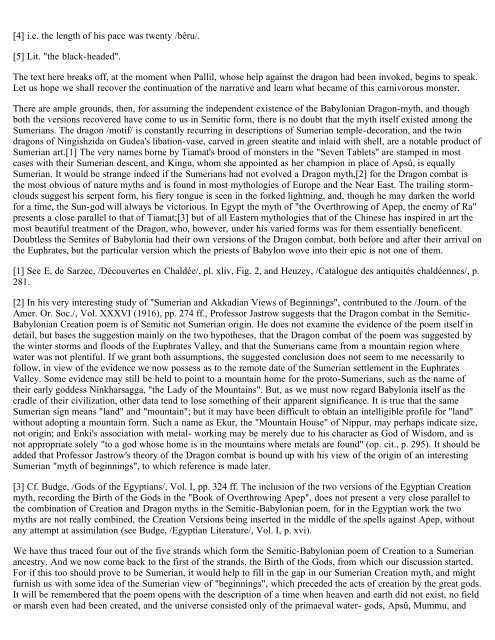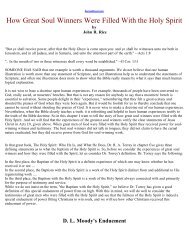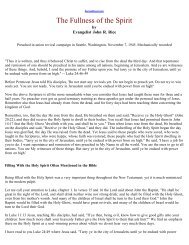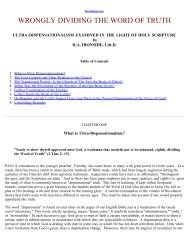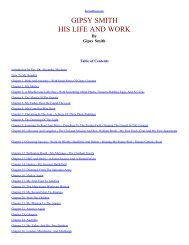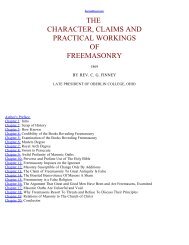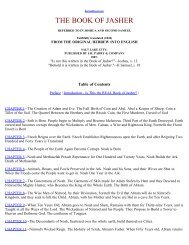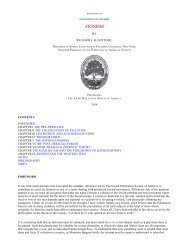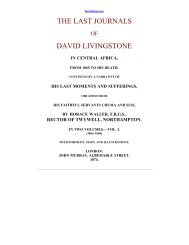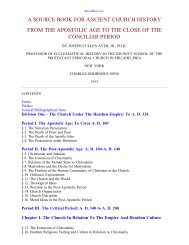Legends of Babylon and Egypt in Relation to Hebrew Tradition.pdf
Legends of Babylon and Egypt in Relation to Hebrew Tradition.pdf
Legends of Babylon and Egypt in Relation to Hebrew Tradition.pdf
Create successful ePaper yourself
Turn your PDF publications into a flip-book with our unique Google optimized e-Paper software.
[4] i.e. the length <strong>of</strong> his pace was twenty /bêru/.<br />
[5] Lit. "the black-headed".<br />
The text here breaks <strong>of</strong>f, at the moment when Pallil, whose help aga<strong>in</strong>st the dragon had been <strong>in</strong>voked, beg<strong>in</strong>s <strong>to</strong> speak.<br />
Let us hope we shall recover the cont<strong>in</strong>uation <strong>of</strong> the narrative <strong>and</strong> learn what became <strong>of</strong> this carnivorous monster.<br />
There are ample grounds, then, for assum<strong>in</strong>g the <strong>in</strong>dependent existence <strong>of</strong> the <strong>Babylon</strong>ian Dragon-myth, <strong>and</strong> though<br />
both the versions recovered have come <strong>to</strong> us <strong>in</strong> Semitic form, there is no doubt that the myth itself existed among the<br />
Sumerians. The dragon /motif/ is constantly recurr<strong>in</strong>g <strong>in</strong> descriptions <strong>of</strong> Sumerian temple-decoration, <strong>and</strong> the tw<strong>in</strong><br />
dragons <strong>of</strong> N<strong>in</strong>gishzida on Gudea's libation-vase, carved <strong>in</strong> green steatite <strong>and</strong> <strong>in</strong>laid with shell, are a notable product <strong>of</strong><br />
Sumerian art.[1] The very names borne by Tiamat's brood <strong>of</strong> monsters <strong>in</strong> the "Seven Tablets" are stamped <strong>in</strong> most<br />
cases with their Sumerian descent, <strong>and</strong> K<strong>in</strong>gu, whom she appo<strong>in</strong>ted as her champion <strong>in</strong> place <strong>of</strong> Apsû, is equally<br />
Sumerian. It would be strange <strong>in</strong>deed if the Sumerians had not evolved a Dragon myth,[2] for the Dragon combat is<br />
the most obvious <strong>of</strong> nature myths <strong>and</strong> is found <strong>in</strong> most mythologies <strong>of</strong> Europe <strong>and</strong> the Near East. The trail<strong>in</strong>g s<strong>to</strong>rmclouds<br />
suggest his serpent form, his fiery <strong>to</strong>ngue is seen <strong>in</strong> the forked lightn<strong>in</strong>g, <strong>and</strong>, though he may darken the world<br />
for a time, the Sun-god will always be vic<strong>to</strong>rious. In <strong>Egypt</strong> the myth <strong>of</strong> "the Overthrow<strong>in</strong>g <strong>of</strong> Apep, the enemy <strong>of</strong> Ra"<br />
presents a close parallel <strong>to</strong> that <strong>of</strong> Tiamat;[3] but <strong>of</strong> all Eastern mythologies that <strong>of</strong> the Ch<strong>in</strong>ese has <strong>in</strong>spired <strong>in</strong> art the<br />
most beautiful treatment <strong>of</strong> the Dragon, who, however, under his varied forms was for them essentially beneficent.<br />
Doubtless the Semites <strong>of</strong> <strong>Babylon</strong>ia had their own versions <strong>of</strong> the Dragon combat, both before <strong>and</strong> after their arrival on<br />
the Euphrates, but the particular version which the priests <strong>of</strong> <strong>Babylon</strong> wove <strong>in</strong><strong>to</strong> their epic is not one <strong>of</strong> them.<br />
[1] See E. de Sarzec, /Découvertes en Chaldée/, pl. xliv, Fig. 2, <strong>and</strong> Heuzey, /Catalogue des antiquités chaldéennes/, p.<br />
281.<br />
[2] In his very <strong>in</strong>terest<strong>in</strong>g study <strong>of</strong> "Sumerian <strong>and</strong> Akkadian Views <strong>of</strong> Beg<strong>in</strong>n<strong>in</strong>gs", contributed <strong>to</strong> the /Journ. <strong>of</strong> the<br />
Amer. Or. Soc./, Vol. XXXVI (1916), pp. 274 ff., Pr<strong>of</strong>essor Jastrow suggests that the Dragon combat <strong>in</strong> the Semitic-<br />
<strong>Babylon</strong>ian Creation poem is <strong>of</strong> Semitic not Sumerian orig<strong>in</strong>. He does not exam<strong>in</strong>e the evidence <strong>of</strong> the poem itself <strong>in</strong><br />
detail, but bases the suggestion ma<strong>in</strong>ly on the two hypotheses, that the Dragon combat <strong>of</strong> the poem was suggested by<br />
the w<strong>in</strong>ter s<strong>to</strong>rms <strong>and</strong> floods <strong>of</strong> the Euphrates Valley, <strong>and</strong> that the Sumerians came from a mounta<strong>in</strong> region where<br />
water was not plentiful. If we grant both assumptions, the suggested conclusion does not seem <strong>to</strong> me necessarily <strong>to</strong><br />
follow, <strong>in</strong> view <strong>of</strong> the evidence we now possess as <strong>to</strong> the remote date <strong>of</strong> the Sumerian settlement <strong>in</strong> the Euphrates<br />
Valley. Some evidence may still be held <strong>to</strong> po<strong>in</strong>t <strong>to</strong> a mounta<strong>in</strong> home for the pro<strong>to</strong>-Sumerians, such as the name <strong>of</strong><br />
their early goddess N<strong>in</strong>kharsagga, "the Lady <strong>of</strong> the Mounta<strong>in</strong>s". But, as we must now regard <strong>Babylon</strong>ia itself as the<br />
cradle <strong>of</strong> their civilization, other data tend <strong>to</strong> lose someth<strong>in</strong>g <strong>of</strong> their apparent significance. It is true that the same<br />
Sumerian sign means "l<strong>and</strong>" <strong>and</strong> "mounta<strong>in</strong>"; but it may have been difficult <strong>to</strong> obta<strong>in</strong> an <strong>in</strong>telligible pr<strong>of</strong>ile for "l<strong>and</strong>"<br />
without adopt<strong>in</strong>g a mounta<strong>in</strong> form. Such a name as Ekur, the "Mounta<strong>in</strong> House" <strong>of</strong> Nippur, may perhaps <strong>in</strong>dicate size,<br />
not orig<strong>in</strong>; <strong>and</strong> Enki's association with metal- work<strong>in</strong>g may be merely due <strong>to</strong> his character as God <strong>of</strong> Wisdom, <strong>and</strong> is<br />
not appropriate solely "<strong>to</strong> a god whose home is <strong>in</strong> the mounta<strong>in</strong>s where metals are found" (op. cit., p. 295). It should be<br />
added that Pr<strong>of</strong>essor Jastrow's theory <strong>of</strong> the Dragon combat is bound up with his view <strong>of</strong> the orig<strong>in</strong> <strong>of</strong> an <strong>in</strong>terest<strong>in</strong>g<br />
Sumerian "myth <strong>of</strong> beg<strong>in</strong>n<strong>in</strong>gs", <strong>to</strong> which reference is made later.<br />
[3] Cf. Budge, /Gods <strong>of</strong> the <strong>Egypt</strong>ians/, Vol. I, pp. 324 ff. The <strong>in</strong>clusion <strong>of</strong> the two versions <strong>of</strong> the <strong>Egypt</strong>ian Creation<br />
myth, record<strong>in</strong>g the Birth <strong>of</strong> the Gods <strong>in</strong> the "Book <strong>of</strong> Overthrow<strong>in</strong>g Apep", does not present a very close parallel <strong>to</strong><br />
the comb<strong>in</strong>ation <strong>of</strong> Creation <strong>and</strong> Dragon myths <strong>in</strong> the Semitic-<strong>Babylon</strong>ian poem, for <strong>in</strong> the <strong>Egypt</strong>ian work the two<br />
myths are not really comb<strong>in</strong>ed, the Creation Versions be<strong>in</strong>g <strong>in</strong>serted <strong>in</strong> the middle <strong>of</strong> the spells aga<strong>in</strong>st Apep, without<br />
any attempt at assimilation (see Budge, /<strong>Egypt</strong>ian Literature/, Vol. I, p. xvi).<br />
We have thus traced four out <strong>of</strong> the five str<strong>and</strong>s which form the Semitic-<strong>Babylon</strong>ian poem <strong>of</strong> Creation <strong>to</strong> a Sumerian<br />
ancestry. And we now come back <strong>to</strong> the first <strong>of</strong> the str<strong>and</strong>s, the Birth <strong>of</strong> the Gods, from which our discussion started.<br />
For if this <strong>to</strong>o should prove <strong>to</strong> be Sumerian, it would help <strong>to</strong> fill <strong>in</strong> the gap <strong>in</strong> our Sumerian Creation myth, <strong>and</strong> might<br />
furnish us with some idea <strong>of</strong> the Sumerian view <strong>of</strong> "beg<strong>in</strong>n<strong>in</strong>gs", which preceded the acts <strong>of</strong> creation by the great gods.<br />
It will be remembered that the poem opens with the description <strong>of</strong> a time when heaven <strong>and</strong> earth did not exist, no field<br />
or marsh even had been created, <strong>and</strong> the universe consisted only <strong>of</strong> the primaeval water- gods, Apsû, Mummu, <strong>and</strong>


